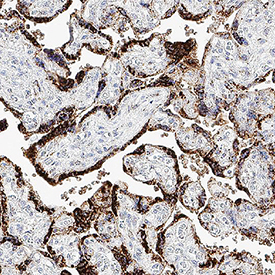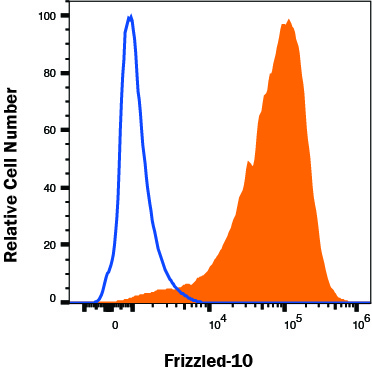Human Frizzled-10 Antibody Summary
Ile21-Gly161
Accession # Q6NSL8
Applications
Please Note: Optimal dilutions should be determined by each laboratory for each application. General Protocols are available in the Technical Information section on our website.
Scientific Data
 View Larger
View Larger
Frizzled‑10 in Human placenta. Frizzled‑10 was detected in immersion fixed paraffin-embedded sections of human placenta using Rabbit Anti-Human Frizzled‑10 Monoclonal Antibody (Catalog # MAB34581) at 0.3 µg/mL for 1 hour at room temperature followed by incubation with the Anti-Rabbit IgG VisUCyte™ HRP Polymer Antibody (VC003). Before incubation with the primary antibody, tissue was subjected to heat-induced epitope retrieval using Antigen Retrieval Reagent-Basic (CTS013). Tissue was stained using DAB (brown) and counterstained with hematoxylin (blue). Specific staining was localized to Syncytiotrophoblast cells. Staining was performed using our protocol for IHC Staining with VisUCyte HRP Polymer Detection Reagents.
 View Larger
View Larger
Detection of Frizzled-10 in NS0 cell line transfected with Human Frizzled-10 by Flow Cytometry. NS0 cell line transfected with human Frizzled-10 was stained with Rabbit Anti-Human Frizzled-10 Monoclonal Antibody (Catalog # MAB34581, filled histogram) or isotype control antibody (MAB1050, open histogram), followed by APC-conjugated Anti-Rabbit IgG Secondary Antibody (F0111). To facilitate intracellular staining, cells were fixed with Flow Cytometry Fixation Buffer (FC004) and permeabilized with Flow Cytometry Permeabilization/Wash Buffer I (FC005). Staining was performed using our protocol for Staining Intracellular Molecules.
Reconstitution Calculator
Preparation and Storage
- 12 months from date of receipt, -20 to -70 °C as supplied.
- 1 month, 2 to 8 °C under sterile conditions after reconstitution.
- 6 months, -20 to -70 °C under sterile conditions after reconstitution.
Background: Frizzled-10
Frizzled-10, also known as CD350, is a 68 kDa seven pass transmembrane glycoprotein in the Frizzled family of Wnt receptors (1, 2). The 205 amino acid N-terminal extracellular region of Frizzled-10 contains a cysteine-rich domain that comprises the Wnt binding domain and mediates receptor oligomerization (3‑5). The C-terminal cytoplasmic tail contains a PDZ-interaction motif (3). PDZ motifs mediate intracellular binding to scaffolding proteins. Within the cysteine-rich domain, human Frizzled‑10 shares 71% amino acid (aa) sequence identity with Frizzled-9 and 31%-46% with Frizzled-1, -2, -3, -4, -5, - 6, -7, and -8. It shares 96%, 94%, 90%, and 82% aa sequence identity with chick, mouse, Xenopus, and zebrafish Frizzled-10, respectively. Frizzled-10 is expressed during embryogenesis in the primitive streak, dorsal neural tube, developing brain, limb bud, and airway epithelium (6-11). It is induced by Shh and colocalizes with Shh and Wnt-7a in the neural tube (12, 13). In the adult, Frizzled-10 is expressed in placenta, gastric glands, and colon and renal tubule epithelial cells (4). Frizzled-10 associates with LRP5 to transduce Wnt-7a and Wnt-7b signals, resulting in the stabilization of cytoplasmic beta-catenin (11, 13). Frizzled-10 is also up-regulated in some cancers and transformed cell lines (4, 14). It binds hypoxia inducible gene 2, which promotes oncogenic Wnt signaling and functions as an autocrine growth factor for renal cell carcinomas (15).
- Kikuchi, A. et al. (2007) Cell. Signal. 19:659.
- Wang, H. et al. (2006) Cell. Signal. 18:934.
- Koike, J. et al. (1999) Biochem. Biophys. Res. Commun. 262:39.
- Nagayama, S. et al. (2005) Oncogene 24:6201.
- Dann, C.E. et al. (2001) Nature 412:86.
- Kemp, C.R. et al. (2007) Dev. Dyn. 236:2011.
- Kawakami, Y. et al. (2000) Mech. Dev. 91:375.
- Nasevicius, A. et al. (2000) Mech. Dev. 92:311.
- Moriwaki, J. et al. (2000) Biochem. Biophys. Res. Commun. 278:377.
- Stark, M.R. et al. (2000) Mech. Dev. 93:195.
- Wang, Z. et al. (2005) Mol. Cell. Biol. 25:5022.
- Nunnally, A.P. and B.A. Parr (2004) Dev. Genes Evol. 214:144.
- Kawakami, Y. et al. (2000) Dev. Growth Differ. 42:561.
- Saitoh, T. et al. (2002) Int. J. Oncol. 20:117.
- Togashi, A. et al. (2005) Cancer Res. 65:4817.
Product Datasheets
FAQs
No product specific FAQs exist for this product, however you may
View all Antibody FAQsReviews for Human Frizzled-10 Antibody
There are currently no reviews for this product. Be the first to review Human Frizzled-10 Antibody and earn rewards!
Have you used Human Frizzled-10 Antibody?
Submit a review and receive an Amazon gift card.
$25/€18/£15/$25CAN/¥75 Yuan/¥2500 Yen for a review with an image
$10/€7/£6/$10 CAD/¥70 Yuan/¥1110 Yen for a review without an image



